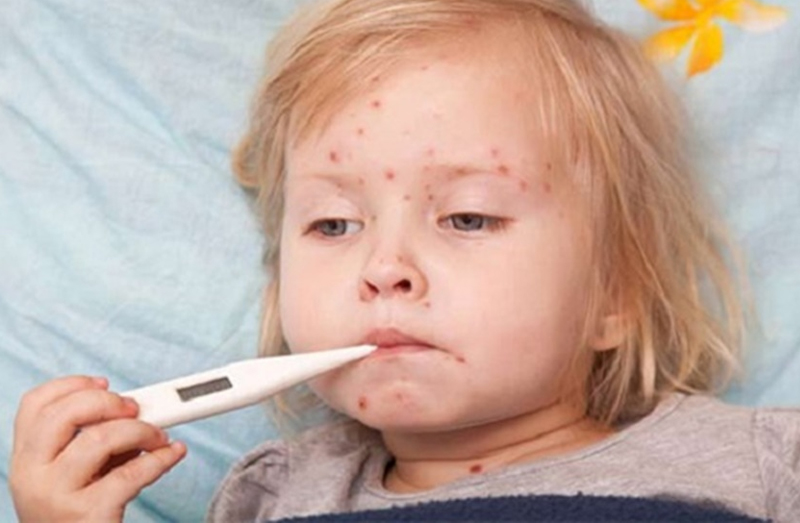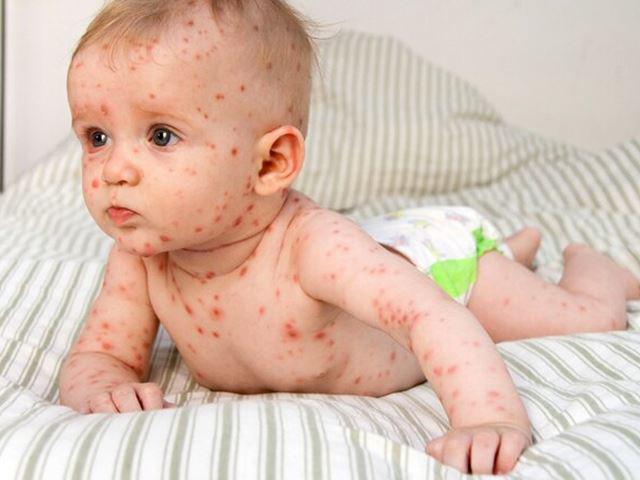1. What is measles in children?
Measles in children is an acute respiratory infectious disease caused by a virus of the genus Morbillivirus of the Paramyxoviridae family. The characteristics to identify measles in children are fever, inflammation of the respiratory and digestive tracts, conjunctivitis, and red rashes spreading from the face to the limbs and the whole body.
2. What are the symptoms of measles in children?
Usually, measles in children will occur in 4 periods, specifically:
- Incubation period: Occurs in about 8 – 11 days, usually at this stage there are no clinical manifestations.
- Onset period: Lasts for 3 – 4 days with symptoms such as mild or moderate fever, high fever. After conjunctivitis, the eyes will be red with watery discharge and swollen eyelids, inflammation and exudation in the nose and throat. Watery eyes, runny nose. Many children may also have enlarged peripheral lymph nodes.
- Full-blown period: Lasts about 4 – 6 days. The red rash will appear in 3 days and appear in order from the face and then gradually spread to the arms, legs and spread to the whole body. The rash of measles in children is pink, maculopapular, small rashes slightly raised on the skin surface, interspersed with healthy skin. The rash appears scattered or can also spread out and stick together into round patches about 3 – 6 mm.
- Remission period: The rash disappears in the same order as when it appeared. After the rash disappears, it leaves dark spots on the skin. Usually, when the rash disappears, the child will no longer have a fever, unless there are complications, the child will still have a fever after the rash disappears.

When infected with measles, children will often have a high fever and a red rash.
3. Why does measles in children develop quickly and become severe?
Winter and spring are ideal times for measles in children to develop and spread. However, in recent years, measles epidemics and measles in children can break out at any time of the year.
We all know that measles in children is an acute infectious disease, often transmitted directly from person to person when we come into direct contact with sick people. Therefore, the disease is even more likely to spread quickly in crowded areas such as offices, schools, residential areas, etc. From there, it spreads and develops into a measles epidemic.
The subjects most likely to get the disease are children, because children have poor resistance. If not detected and treated promptly, the disease can develop in a bad direction, causing dangerous complications such as encephalitis, pneumonia, otitis media, …. and can even lead to death.
According to medical experts, there is currently no specific medicine to treat measles in children. The basic treatment method is to overcome the symptoms of the disease, combined with improving nutrition and personal hygiene.

Measles in children can progress very quickly.
4. Measures for child care and prevention of measles in children
For measles in children, we need to pay close attention and take careful care in caring for children.
- Isolate children with measles from other healthy children.
- When seeing that the child has a fever >38.5 degrees Celsius, give the child fever-reducing medicine as prescribed by the doctor.
- Caregivers need to wear masks, wash their hands before and after each contact with the child to avoid infection.
- Keep the child clean such as bathing daily, do not let the child get cold. Change clothes, clean the surrounding environment, keep the room airy and clean.
- Cut nails to prevent children from scratching and scratching the skin.
- Avoid the notion that children should abstain from bathing and avoiding wind, which will make measles in children worse.
- Regularly use 0.9% saline solution in the eyes.
- Feed children easily digestible foods, cook them thoroughly and feed them in many meals.

Parents should pay close attention to the care of children with measles.
How to prevent children from being infected with measles virus and measles. Medical experts often recommend the following measures:
- Vaccination: Vaccination is the safest way to prevent measles. Normally, the first dose of measles vaccine is given when the child is 9 months old, the second dose when the child is 18 months old. In case of exposure to the source of infection, immune globulin can be used to prevent or reduce the severity of measles.
- Personal hygiene and surrounding environment: When we know that the child has measles, isolate them from other healthy children. Daily personal hygiene for children and frequent hand washing with water or antibacterial soap. Clean the house and common areas with soap or regular detergent to limit infection.





